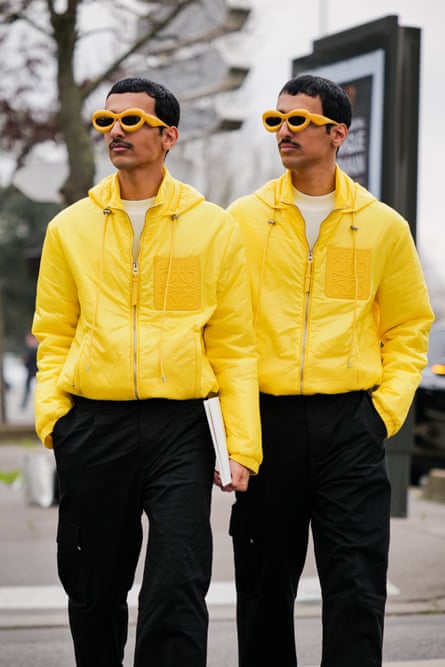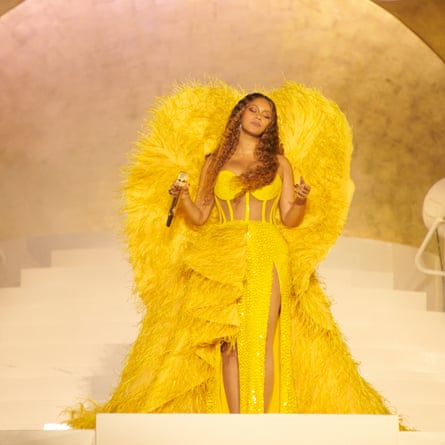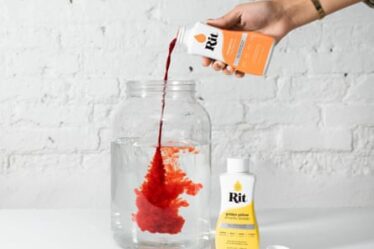
Instagram-famous skincare packaging, designer runways, and red carpet gowns have moved on from millennial pink, the hue that captivated and coddled “girlbosses” through the late 2010s. Instead, make way for Gen Z yellow. But can a generation famous for its fractured individualism really unite behind the color of caution tape?
Gen Z yellow is similar to one of Pantone’s Colors of the Year for 2021, “illuminating,” a dose of canary meant to herald brighter, post-pandemic days. So it makes sense spring 2023 runways such as Alexander McQueen and Moschino featured the color. (Although the history of Gen Z yellow goes all the way back to 2017, when the writer Haley Nahman coined it in an essay on the now defunct blog Man Repeller.)
Still, you will not find Gen Z yellow infiltrating every facet of design in the same way that millennial pink once did. Blame it on the shade being rather “bold”, as the Business of Fashion euphemistically puts it. Millennial pink won fans for its calming nature; its successor is less easy on the eyes. Gen Z’s “individualistic attitudes” also do not do any favors for its namesake color; young people prefer to tout their own unique style, not follow trends.
Véronique Hyland is the fashion features director of Elle magazine and the author of Dress Code: Unlocking Fashion from the New Look to Millennial Pink. She’s also the first person who put “millennial” in front of pink for a 2016 piece in the Cut – which she now has some regrets about. She’s not buying the idea that yellow is the official color of Gen Z – or that young people need any official color at all.
“This feels like a manufactured marketing thing to me,” Hyland told the Guardian. Of course, the same could be said for millennial pink, though Hyland notes the color was in the ether before brands picked up on it. “I think there’s been a push to make various Gen Z colors happen – à la ‘fetch’ from Mean Girls – that I’ve been seeing since at least 2017, but it has not reached the same kind of ubiquity,” she said.
Millennial pink thrived in a sense because its eponymous generation wanted to fit in; Hyland doesn’t think Gen Z has the same desire. “Millennials in the 2010s were trying to adapt to an existing culture, and Gen Z is more willing to question the prevailing culture,” she said. “Even if you look at their response to the climate crisis, there’s an understanding of urgency and need to make themselves heard without timidity.”
Martin Kesselman, an interior designer and owner of the high-end New York paint shop Incolour, said he still regularly gets inquiries about millennial pink, even seven years after its supposed peak. “It gets more attention and translates to interiors more so than this Gen Z yellow does,” he said. “This isn’t my first time hearing about yellow, but it doesn’t come up in conversation as much.”

Read about Gen Z yellow, and you’re bound to learn a few tropes: the color represents hopefulness and optimism, two feelings that young people are desperate for in a precarious reality. “It spurs excitement, creativity, and stimulation,” Kesselman said.
For Peggy Van Allen, a designer and president of the trade association Color Marketing Group, this presents an opportunity for branding experts to align their products with customers’ emotions. “The younger generation is drawn to yellow because of its expressive and hopeful qualities,” she said. “Marketers use the color to speak to a consumer who is looking to be empowered.”
But they’re also speaking to a consumer who knows all of these branding tricks. If Gen Z yellow feels too forced, its target demographic just might shun it. “When older generations see this popularity and use the color more, Gen Z yellow becomes too saturated,” said Nick Kolenda, who studies the psychology of marketing. “So now Gen Z might need to search for new, uncharted territory when it comes to finding their own shade.”


